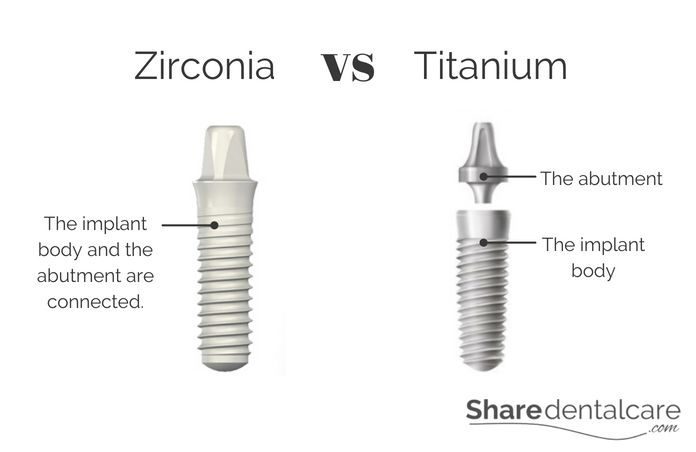The future of dental implants is being shaped by new materials like zirconia, which can fuse well with the human jawbone. But what are your options if you need one today? Zirconia vs titanium dental implants. Titanium implants have been used traditionally and are effective in replacing missing teeth. Zirconia has also proven itself as an alternative that’s generally durable enough for use over time while also offering a very similar color to natural teeth. When considering zirconia vs titanium implants, it’s important to keep some key things in mind: cost, strength, and durability over time and the risk level.
Zirconia Implants are a Newer Alternative to Titanium
Zirconia dental implants are a newer option that’s been gaining popularity, as it’s made with a synthetic material. Zirconia is a material that has been used in dentistry since the 1990s and is an excellent option for people with allergies to metal or who may have difficulty with titanium. It can also be made in different colors to match your teeth, which makes them more aesthetically pleasing than traditional materials like steel or gold. However, zirconia implants have not been used long enough to understand their long-term success.
What are The Differences between Zirconia vs Titanium Implants?
Dental implants are a common option for tooth replacement. They have been used in dentistry since the 1960s. Dental implants can be made from titanium or zirconia. Titanium implants are very popular because they have been used for many years and are well proven in terms of body compatibility, stability, and durability. They consist of 2 pieces:
- The implant body: it is inserted into the jawbone (under the gumline) and fuses with the surrounding bone tissue (osseointegration).
- The abutment: it connects the implant body with the dental prosthesis (crowns, bridges, and dentures).
Zirconia implants are usually one piece. This means that the implant body and the abutment are connected. Compared to titanium implants, zirconia implants haven’t been used long enough to understand their long-term success.

Material of Implants
Zirconia is a very hard ceramic. It is used in dentistry in the manufacture of crowns, bridges, and dental implants. Zirconia is biocompatible, aesthetic, strong, and very expensive.
Titanium is a metal with a silver color that is used in the medical field for decades, including hip and knee replacements, and dental implants. Titanium is strong as steel and 40% lighter in weight. it is known for its biocompatibility, high strength, and corrosion resistance.
Biocompatibility & Osseointegration
Zirconia and titanium implants are compatible with the human body. They fuse with the jawbone and perform the same function as the original tooth roots. This process is known as osseointegration which involves a direct fusion between titanium and zirconia implants and living bone tissue. This process usually takes 4-6 months to complete, depending on the bone density. Zirconia implants are metal-free, so it is suitable for patients who are allergic to metals. Zirconia is more malleable than titanium, so fitting the abutment to the implant may be a little easier. Zirconia implants are also less costly than their titanium counterparts.
Strength of Zirconia vs Titanium implants
The main difference between zirconia vs titanium implants in terms of strength is that zirconia is not as strong as titanium. Titanium has good mechanical properties compared to other metals. Titanium is an ideal material for implants because it resists fracture in places with high chewing loads. Also, zirconia implants are very hard and strong. However, ceramics are not as resistant to breakage as metals. So, they may fracture in places with a high chewing load.
Aesthetic of Zirconia vs Titanium implants
If the patient has a thin bone or thin gum, titanium implants may develop a grey line under the gum, causing an aesthetic problem. The color of zirconia implants is very similar to the color of natural teeth. Therefore, they are suitable in places that have a thin gum, thin bone, or a possible gum recession, and the implant could shine through.
The Placement
Titanium implants consist of 2 pieces: the implant body and the abutment (straight or angulated). So, they give the dentist more control during the placement process. In some cases, the dentist needs to place the implant body at a slight angle because of the bone density and the optimal position of the implant. Then, they use a straight or angulated abutment to make the smile line and bite alignment more natural.
The placement of zirconia implants is more challenging because the implant body and the abutment are usually connected (one piece). Now, 2 piece zirconia implants are available. However, they have not yet been widely tested. In the case of full-arch dental implants, titanium implants are a better choice than zirconia implants.
Durability of Zirconia vs Titanium implants
Titanium implants have been used for many years. Therefore, they are well proven in terms of stability and durability. Titanium implants have a long-term success rate of 95%. They can last 20 years on average. Zirconia implants haven’t been used long enough to understand their long-term success.
FAQ about Zirconia vs Titanium Implants
Titanium is stronger and more durable than zirconia, but zirconia implants are more biocompatible with the human body. Titanium implants have a success rate of up to 95%, while zirconia is less than that. Zirconia does not have any metal in its composition, so it is an excellent choice for patients who are allergic to metals.
Yes, zirconia implants cost more than titanium. Zirconia is considered a new material, and its costs are bound to come down in the future.
Titanium implants have a long-term success rate of 95%. They can last 20 years on average. Titanium implants can last a lifetime with proper maintenance.
Zirconia implants are still relatively new, clinical studies are quite limited about their long-term success and viability.